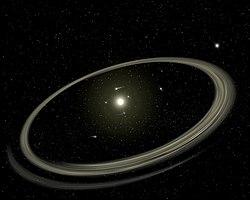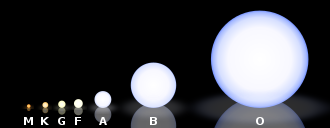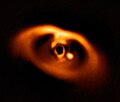Planetary system

A planetary system consists of a set of non-stellar
As of 17 April 2025, there are 5,943 confirmed exoplanets in 4,461 planetary systems, with 976 systems having more than one planet.[5] Debris disks are known to be common while other objects are more difficult to observe.
Of particular interest to astrobiology is the habitable zone of planetary systems where planets could have surface liquid water, and thus, the capacity to support Earth-like life.
History
Heliocentrism
Some interpret
The idea was first proposed in
Discovery of the Solar System
Speculation on extrasolar planetary systems
In the 16th century the Italian philosopher Giordano Bruno, an early supporter of the Copernican theory that Earth and other planets orbit the Sun, put forward the view that the fixed stars are similar to the Sun and are likewise accompanied by planets. He was burned at the stake for his ideas by the Roman Inquisition.[8]
In the 18th century, the same possibility was mentioned by
His theories gained popularity through the 19th and 20th centuries despite a lack of supporting evidence. Long before their confirmation by astronomers, conjecture on the nature of planetary systems had been a focus of the search for extraterrestrial intelligence and has been a prevalent theme in fiction, particularly science fiction.
Detection of exoplanets
The first confirmed detection of an
Origin and evolution

Planetary systems come from protoplanetary disks that form around stars as part of the process of star formation.
During formation of a system, much material is gravitationally-scattered into distant orbits, and some planets are ejected completely from the system, becoming rogue planets.
Evolved systems
High-mass stars
Planets orbiting pulsars have been discovered. Pulsars are the remnants of the supernova explosions of high-mass stars, but a planetary system that existed before the supernova would likely be mostly destroyed. Planets would either evaporate, be pushed off of their orbits by the masses of gas from the exploding star, or the sudden loss of most of the mass of the central star would see them escape the gravitational hold of the star, or in some cases the supernova would kick the pulsar itself out of the system at high velocity so any planets that had survived the explosion would be left behind as free-floating objects. Planets found around pulsars may have formed as a result of pre-existing stellar companions that were almost entirely evaporated by the supernova blast, leaving behind planet-sized bodies. Alternatively, planets may form in an accretion disk of fallback matter surrounding a pulsar.[10] Fallback disks of matter that failed to escape orbit during a supernova may also form planets around black holes.[11]
Lower-mass stars

As stars evolve and turn into red giants, asymptotic giant branch stars, and planetary nebulae they engulf the inner planets, evaporating or partially evaporating them depending on how massive they are.[13][14] As the star loses mass, planets that are not engulfed move further out from the star.
If an evolved star is in a binary or multiple system, then the mass it loses can transfer to another star, forming new protoplanetary disks and second- and third-generation planets which may differ in composition from the original planets, which may also be affected by the mass transfer.
System architectures
The Solar System consists of an inner region of small
Classification
Planetary system architectures may be partitioned into four classes based on how the mass of the planets is distributed around the
- Similar: The masses of all planets in a system are similar to each other. This architecture class is the most commonly-observed in our galaxy. Examples include Trappist-1. The planets in these systems are said to be like 'peas in a pod'.[23]
- Mixed: The masses of planets in a system show large increasing or decreasing variations. Examples of such systems are Gliese 876 and Kepler-89.
- Anti-Ordered: The massive planets of a system are close to the star and smaller planets are further away from the star. There are currently no known examples of this architecture class.
- Ordered: The mass of the planets in a system tends to increase with increasing distance from the host star. The Solar System, with small rocky planets in the inner part and giant planets in the outer part, is a type of Ordered system.
Peas in a pod
Multiplanetary systems tend to be in a "peas in a pod" configuration meaning they tend to have the following factors:[23]
- Size: planets within a system tend to be either similar or ordered in size.
- Mass: planets within a system tend to be either similar or ordered in mass.
- Spacing: planets within a system tend to be equally spaced apart.
- Packing: small planets tend to be closely packed together, while large planets tend to have larger spacing.
Components
Planets and stars

Most known exoplanets orbit stars roughly similar to the
Circumstellar disks and dust structures
After planets, circumstellar disks are one of the most commonly-observed properties of planetary systems, particularly of young stars. The Solar System possesses at least four major circumstellar disks (the asteroid belt, Kuiper belt, scattered disc, and Oort cloud) and clearly-observable disks have been detected around nearby solar analogs including Epsilon Eridani and Tau Ceti. Based on observations of numerous similar disks, they are assumed to be quite common attributes of stars on the main sequence.
Comets
As of November 2014[update] there are 5,253 known Solar System comets
Other components
Computer modelling of an impact in 2013 detected around the star NGC 2547-ID8 by the Spitzer Space Telescope, and confirmed by ground observations, suggests the involvement of large asteroids or protoplanets similar to the events believed to have led to the formation of terrestrial planets like the Earth.[38]
Based on observations of the Solar System's large collection of natural satellites, they are believed common components of planetary systems; however, the existence of
Orbital configurations
Unlike the Solar System, which has orbits that are nearly circular, many of the known planetary systems display much higher orbital eccentricity.[41] An example of such a system is 16 Cygni.
Mutual inclination
The mutual
Orbital dynamics
Planetary systems can be categorized according to their orbital dynamics as resonant, non-resonant-interacting, hierarchical, or some combination of these. In resonant systems the orbital periods of the planets are in integer ratios. The Kepler-223 system contains four planets in an 8:6:4:3 orbital resonance.[45] Giant planets are found in mean-motion resonances more often than smaller planets.[46] In interacting systems the planets' orbits are close enough together that they perturb the orbital parameters. The Solar System could be described as weakly interacting. In strongly interacting systems
Other, as yet unobserved, orbital possibilities include: double planets; various co-orbital planets such as quasi-satellites, trojans and exchange orbits; and interlocking orbits maintained by precessing orbital planes.[48]
Number of planets, relative parameters and spacings

- On The Relative Sizes of Planets Within Kepler Multiple Candidate Systems, David R. Ciardi et al. December 9, 2012
- The Kepler Dichotomy among the M Dwarfs: Half of Systems Contain Five or More Coplanar Planets, Sarah Ballard, John Asher Johnson, October 15, 2014
- Exoplanet Predictions Based on the Generalised Titius-Bode Relation, Timothy Bovaird, Charles H. Lineweaver, August 1, 2013
- The Solar System and the Exoplanet Orbital Eccentricity - Multiplicity Relation, Mary Anne Limbach, Edwin L. Turner, April 9, 2014
- The period ratio distribution of Kepler's candidate multiplanet systems, Jason H. Steffen, Jason A. Hwang, September 11, 2014
- Are Planetary Systems Filled to Capacity? A Study Based on Kepler Results, Julia Fang, Jean-Luc Margot, February 28, 2013
Planet capture
Free-floating planets in open clusters have similar velocities to the stars and so can be recaptured. They are typically captured into wide orbits between 100 and 105 AU. The capture efficiency decreases with increasing cluster size, and for a given cluster size it increases with the host/primary[clarification needed] mass. It is almost independent of the planetary mass. Single and multiple planets could be captured into arbitrary unaligned orbits, non-coplanar with each other or with the stellar host spin, or pre-existing planetary system. Some planet–host metallicity correlation may still exist due to the common origin of the stars from the same cluster. Planets would be unlikely to be captured around neutron stars because these are likely to be ejected from the cluster by a pulsar kick when they form. Planets could even be captured around other planets to form free-floating planet binaries. After the cluster has dispersed some of the captured planets with orbits larger than 106 AU would be slowly disrupted by the galactic tide and likely become free-floating again through encounters with other field stars or giant molecular clouds.[49]
Zones
Habitable zone

The habitable zone around a star is the region where the temperature range allows for liquid water to exist on a planet; that is, not too close to the star for the water to evaporate and not too far away from the star for the water to freeze. The heat produced by stars varies depending on the size and age of the star; this means the habitable zone will also vary accordingly. Also, the atmospheric conditions on the planet influence the planet's ability to retain heat so that the location of the habitable zone is also specific to each type of planet.
Habitable zones have usually been defined in terms of surface temperature; however, over half of Earth's biomass is from subsurface microbes,[50] and temperature increases as depth underground increases, so the subsurface can be conducive for life when the surface is frozen; if this is considered, the habitable zone extends much further from the star.[51]
Studies in 2013 indicate that an estimated 22±8% of Sun-like[a] stars have an Earth-sized[b] planet in the habitable[c] zone.[52][53]
Venus zone
The Venus zone is the region around a star where a
Galactic distribution of planets
The
Population I, or metal-rich stars, are those young stars whose
Population II, or metal-poor stars, are those with relatively low metallicity which can have hundreds (e.g.
Different types of galaxies have different histories of star formation and hence planet formation. Planet formation is affected by the ages, metallicities, and orbits of stellar populations within a galaxy. Distribution of stellar populations within a galaxy varies between the different types of galaxies.[63] Stars in elliptical galaxies are much older than stars in spiral galaxies. Most elliptical galaxies contain mainly low-mass stars, with minimal star-formation activity.[64] The distribution of the different types of galaxies in the universe depends on their location within galaxy clusters, with elliptical galaxies found mostly close to their centers.[65]
See also
- Comparison between the Solar System and extrasolar systems
- Protoplanetary disk
- List of exoplanets
- List of multiplanetary systems
Notes
- K-type stars
- ^ For the purpose of this 1 in 5 statistic, Earth-sized means 1–2 Earth radii
- ^ For the purpose of this 1 in 5 statistic, "habitable zone" means the region with 0.25 to 4 times Earth's stellar flux (corresponding to 0.5–2 AU for the Sun).
- ^ For the purpose of this, terrestrial-sized means 0.5–1.4 Earth radii, the "Venus zone" means the region with approximately 1 to 25 times Earth's stellar flux for M and K-type stars and approximately 1.1 to 25 times Earth's stellar flux for G-type stars.
- Kapteyn's starestimated at [Fe/H]= −0.89. 10−0.89 ≈ 1/8
References
- ISBN 978-0-471-26569-6.
- ISBN 978-0-00-710297-6.
- ^ p. 382, Collins Dictionary of Astronomy.
- ISBN 978-0-19-860513-3.
- The Extrasolar Planets Encyclopedia. Retrieved April 17, 2025.
- ^ Noel Swerdlow, "Review: A Lost Monument of Indian Astronomy," Isis, 64 (1973): 239–243.
- ^ Dreyer (1953), pp.135–48; Linton (2004), pp.38–9). The work of Aristarchus's in which he proposed his heliocentric system has not survived. We only know of it now from a brief passage in Archimedes's The Sand Reckoner.
- ^ "Cosmos" in The New Encyclopædia Britannica (15th edition, Chicago, 1991) 16:787:2a. "For his advocacy of an infinity of suns and earths, he was burned at the stake in 1600."
- ^
Newton, Isaac; Cohen, I. Bernard; Whitman, Anne (1999) [First published 1713]. The Principia: A New Translation and Guide. University of California Press. p. 940. ISBN 0-520-20217-1.
- Bibcode:1993ASPC...36..149P.
- .
- ^ "Sculpting Solar Systems - ESO's SPHERE instrument reveals protoplanetary discs being shaped by newborn planets". www.eso.org. Retrieved December 7, 2016.
- ^ Ferreira, Becky (May 3, 2023). "It's the End of a World as We Know It - Astronomers spotted a dying star swallowing a large planet, a discovery that fills in a "missing link" in understanding the fates of Earth and many other planets". The New York Times. Archived from the original on May 3, 2023. Retrieved May 3, 2023.
- ^ Ferreira, Becky (August 19, 2022). "The Juicy Secrets of Stars That Eat Their Planets - As scientists study thousands of planets around the galaxy, they are learning more about worlds that get swallowed up by their stars". The New York Times. Retrieved August 19, 2022.
- S2CID 118843952.
- S2CID 4304777.
- ^ "We're in the cosmic 1% – planetplanet". February 8, 2021. Retrieved January 25, 2025.
- ^ Types and Attributes at Astro Washington.com.
- ISSN 0004-637X.)
{{cite journal}}: CS1 maint: multiple names: authors list (link - ^ "Hot Super-Earths (and mini-Neptunes)! – planetplanet". March 3, 2014. Retrieved January 25, 2025.
- ISSN 0004-6361.
- ISSN 0004-6361.
- ^ ISSN 0004-6361.
- S2CID 10979195.
- S2CID 59569803.
- S2CID 52233547.
- S2CID 12112032.
- ^ S2CID 13144157.
- S2CID 18317389.
- ^ Johnston, Robert (August 2, 2014). "Known populations of solar system objects". Archived from the original on June 9, 2019. Retrieved January 19, 2015.
- Bibcode:1987A&A...185..267F.
- Bibcode:1990A&A...236..202B.
- ^ Bibcode:1990A&A...227L..13L.
- ^ Bibcode:1997A&A...325..228L.
- ^ doi:10.1086/671757.
- ^ S2CID 118533377.
- ^ "'Exocomets' Common Across Milky Way Galaxy". Space.com. January 7, 2013. Retrieved January 8, 2013.
- ^ "NASA's Spitzer Telescope Witnesses Asteroid Smashup". NASA Jet Propulsion Laboratory (JPL). Retrieved May 17, 2025.
- ^ "Saturn-like ring system eclipses Sun-like star". ScienceDaily. Retrieved May 17, 2025.
Mamajek thinks his team could be either observing the late stages of planet formation if the transiting object is a star or brown dwarf, or possibly moon formation if the transiting object is a giant planet.
- ^ Российские астрономы впервые открыли луну возле экзопланеты (in Russian) – "Studying of a curve of change of shine of WASP-12b has brought to the Russian astronomers unusual result: regular splashes were found out.<...> Though stains on a star surface also can cause similar changes of shine, observable splashes are very similar on duration, a profile and amplitude that testifies for benefit of exomoon existence."
- ^ Dvorak, R.; Pilat-Lohinger, E.; Bois, E.; Schwarz, R.; Funk, B.; Beichman, C.; Danchi, W.; Eiroa, C.; Fridlund, M.; Henning, T.; Herbst, T.; Kaltenegger, L.; Lammer, H.; Léger, A.; Liseau, R.; Lunine, Jonathan I.; Paresce F, Penny, A.; Quirrenbach, A.; Röttgering, H.; Selsis, F.; Schneider, J.; Stam, D.; Tinetti, G.; White, G.; "Dynamical habitability of planetary systems", Institute for Astronomy, University of Vienna, Vienna, Austria, January 2010
- S2CID 119295498.
- S2CID 118409453.
- ^ "NASA – Out of Whack Planetary System Offers Clues to a Disturbed Past". Nasa.gov. May 25, 2010. Retrieved August 17, 2012.
- ^ Emspak, Jesse (March 2, 2011). "Kepler Finds Bizarre Systems". International Business Times. International Business Times Inc. Retrieved March 2, 2011.
- S2CID 6867394.
- arXiv:1006.3834 [astro-ph.EP].
- S2CID 14922361.
- .
- .
- ^ Further away planets 'can support life' say researchers, BBC, January 7, 2014 Last updated at 12:40
- ^ Sanders, R. (November 4, 2013). "Astronomers answer key question: How common are habitable planets?". newscenter.berkeley.edu. Archived from the original on November 7, 2014. Retrieved November 6, 2014.
- PMID 24191033.
- ^ Habitable Zone Gallery - Venus
- S2CID 119178082.
- ^ SAG 11: Preparing for the WFIRST Microlensing Survey Archived February 22, 2014, at the Wayback Machine, Jennifer Yee
- ^ Toward a New Era in Planetary Microlensing Archived November 3, 2014, at the Wayback Machine, Andy Gould, September 21, 2010
- .
- S2CID 14077895.
- doi:10.1086/152434.
- .
- .
- PMID 16254692.
- doi:10.1086/157753.
Further reading
- Kóspál, Ágnes; Ardila, David R.; Moór, Attila; Ábrahám, Péter (2009). "On the Relationship Between Debris Disks and Planets". The Astrophysical Journal. 700 (2): L73 – L77. S2CID 16636256.
- Ozernoy, Leonid M.; Gorkavyi, Nick N.; Mather, John C.; Taidakova, Tanya A. (2000). "Signatures of Exosolar Planets in Dust Debris Disks". The Astrophysical Journal. 537 (2): L147 – L151. S2CID 1149097.

